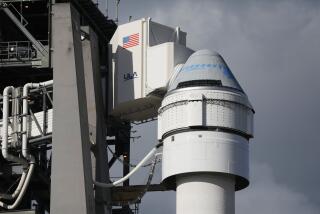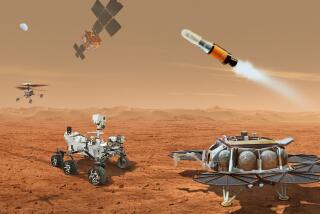$180-Billion Space Station Cost Figure Sparks Debate
- Share via
WASHINGTON — An Orange County conservative and a Bay Area liberal squared off Wednesday in an acrimonious congressional debate over the long-term costs of Space Station Freedom--a project that could provide as much as $4 billion in contracts to an Orange County aerospace company.
Reps. Christopher Cox (R-Newport Beach) and Barbara Boxer (D-Greenbrae) faced each other during a hearing on a report that concluded that building and operating the space station over the next 36 years could cost $180 billion, more than double the $84 billion price tag that NASA has put on the project.
However, a separate study by the General Accounting Office, the investigative arm of Congress, estimates the cost at $118 billion, and the head of the National Aeronautics and Space Administration said both figures are far too high.
The wildly divergent estimates fueled a contentious debate over space station cost-accounting before a House Government Operations subcommittee chaired by Boxer. At the hearing, Boxer accused NASA officials of concealing the real bottom line of long-term space station operations.
“The space station’s cost has been vastly under-reported to Congress,” she said. “Its long list of promised capabilities (has) dwindled down to a pair of missions that renowned scientists say have little merit in relation to the cost.”
But Cox, the ranking Republican on the transportation subcommittee, criticized the accounting methods that congressional staffers used to come up with their $180-billion estimate.
“I think what we’re talking about here is apples and oranges,” said the Orange County conservative, whose district borders Huntington Beach, home to McDonnell Douglas Space Systems Co., one of the major space station contractors.
NASA Administrator Richard H. Truly told Boxer: “It is a question of accounting responsibility, not a question of hiding costs.”
The value of McDonnell Douglas contracts for the space station could reach $4 billion, according to company officials. Cutbacks in the station program already prompted the company to trim its 12,000 person work force by about 300 last January. About 2,000 employees are working directly on the station at several locations around the country. The company employs about 7,000 at its Huntington Beach plant.
Boxer, meanwhile, has called on NASA to pay for an independent audit of space station costs, a request that NASA says could cost up to $400,000. The agency has not yet acted on the request.
The dispute over long-term space station costs centers largely on the question of how to account for the cost of space shuttle missions needed to build and service the space platform.
The questions have arisen as Congress begins consideration of a new, scaled-back plan for the beleaguered program, which officials say represents NASA’s last chance to launch Space Station Freedom.
Last year, congressional appropriations committees, citing acute budget problems, ordered NASA to trim spending on the station by almost $6 billion over the next six years.
In response, NASA unveiled a new design for the station in March that dramatically reduced its capabilities. For example, the date for permanently manning the station was pushed back from 1996 to 1999 or 2000; the power supply was cut from 75 to 57.5 kilowatts, and the size of the permanent crew was reduced from eight to four astronauts.
The new design was immediately attacked by prominent scientific groups, including the Space Studies Board of the prestigious National Research Council. The board, which was represented at Wednesday’s hearing, concluded that the new design “does not meet the basic research requirements of the two principal scientific disciplines for which it is intended”: life sciences and microgravity research.
Nevertheless, the Bush Administration, through the National Space Council, vowed to press forward with the project and is seeking the $2.1-billion appropriation for fiscal 1992 that Congress last year informally promised to provide. If NASA does not get that money, officials have said the station program could be in serious jeopardy.
At Wednesday’s hearing, Truly called on Congress to provide continued, stable funding for the project.
“I see an opportunity this year to take the Congress at its word,” Truly said. “The space station program has had enough reviews. . . If we continue on this funding seesaw . . . we’re going to waste a huge amount of money in the future.”
NASA has said it will cost $30 billion to build the space station--three huge solar power arrays and two 27-foot long laboratory and living modules hung from a giant metal truss--to the point where it can be permanently occupied by a four-member crew. The $30 billion includes $4.5 billion already spent on development, and will comprise total station costs through the year 2000.
In addition, Truly said NASA roughly estimates that the cost of operating the station will be $2 billion a year. Using NASA’s figures, building the station and operating it for 30 years, beginning with a crew-tended capability in 1997, would cost a total of $84 billion.
The subcommittee staff, however, concluded that it will cost $51.8 billion to build the station, and another $130 billion to operate it through the year 2027, for a total cost of nearly $182 billion.
The General Accounting Office, on the other hand, said NASA will spend $118 billion--$40 billion to build the station, and another $78 billion to operate it between the years 2000 and 2027.
The major difference in the figures involves the way that NASA, the GAO and the subcommittee staff calculated the cost of the shuttle missions needed to build and resupply the space station.
The committee staff based its estimate on the full cost of each shuttle mission to the station, which it calculated at $615 million in 1990 dollars. The staff derived that figure by dividing the total shuttle budget for fiscal 1990--$3.6 billion--by the total number of flights that year--six.
Using those figures, four shuttle flights to the station each year between 2000 and 2027 would cost $66 billion more than NASA is projecting.
The GAO, however, counted only the marginal cost of each shuttle flight, over and above the fixed costs of the shuttle program. That accounting method led to an estimated additional cost of only $8.6 billion for 108 shuttle flights over 27 years.
Other figures in dispute involve the cost of a spacecraft needed to return the station crew to Earth in the event of an emergency, such as another catastrophic shuttle accident; the cost of adding enough power and working space to accommodate an eight-member crew, as called for in international scientific agreements; and the price tag for a centrifuge needed to conduct scientific experiments.
More to Read
Get the L.A. Times Politics newsletter
Deeply reported insights into legislation, politics and policy from Sacramento, Washington and beyond. In your inbox twice per week.
You may occasionally receive promotional content from the Los Angeles Times.










